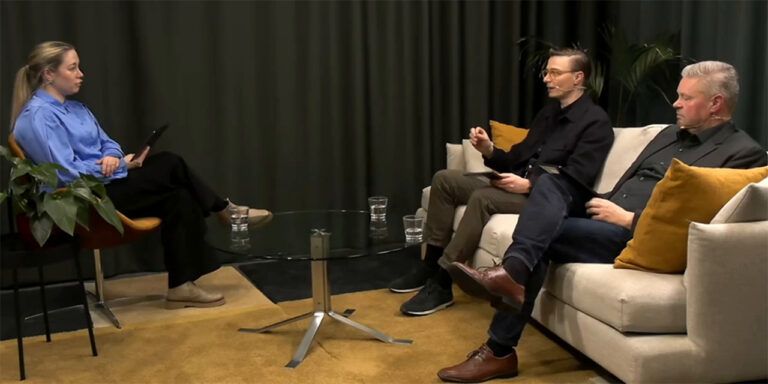Q&A: How AI turns promos into profit
Feb 5, 2025 • 11 min
We sat down with Jeff Bulger, Strategic Principal at RELEX, to talk about how best to implement and scale AI in promotions planning. Before he joined RELEX, Jeff understood the other side of the coin, working in numerous retail roles before focusing on Lifecycle Pricing.
Here, he breaks down how retailers use RELEX AI to quickly analyze large swathes of data, coordinate company-wide planning and strategy, and improve vendor negotiations to achieve profitable, customer-centric promotions.
Q: Okay, Jeff, set the scene for us. What challenges surround current promotional strategies?
Jeff: First off, retailers have a lot of data and often lack the technology to make that data useful.
A grocer might have about 52,000 SKUs on their shelves, and they’ll promote around 14,000 items every week through temporary price reductions, actual discounts, or preferential placements. Without a fast, efficient way to process this data, there’s a real danger of getting promotions wrong. Companies have gone out of business because their promotions were too deep, too wide, and too broad.
Second, shopping habits have changed in recent years.
Go back to 2020 for a moment. We were all stuck at home in our sweatpants, ordering groceries online. Suddenly, people realized they could save real money by buying different items from different stores. Maybe one store is great for basics like milk and bread. Another store has the freshest meat and produce. Another has the best baked goods and deli items. Everyone started comparison shopping and coupon clipping on a scale the industry hadn’t seen before.
That pattern has stuck around. In 2023, promotions drove $1 trillion in sales. These new consumer buying behaviors have made smart promotions table stakes for retailers.

Q: What’s stopping planners from addressing these challenges with their current tech stacks?
Jeff: Figuring out which items to discount is only half the battle. Think of how many types of promotions retailers can run to achieve business objectives like driving sales and profit or increasing traffic or basket size. Planners also have to determine the discount depth and placement. Once that’s done, they often still don’t know if the promotion will succeed!
That’s because two things hamper the planning process: lack of data-driven analysis and siloed planning.
Let’s tackle data first. Most companies have significant technical debt when it comes to pricing and promo planning. Only 12% of retailers use advanced analytics, and most are missing out on almost a decade’s worth of tech improvements.
And it’s not that retailers aren’t paying attention. 74% list “improving promotional performance” as a top priority. But without AI, you just can’t achieve the in-depth analysis you need, with the amount of data you have, at the speed the market requires.
For example, a vendor typically sends the promo team a spreadsheet of every item they want to promote. A planner might get a list of 100 proposed promotions, but they can’t check the potential effect of each one. They don’t have a tool that can instantly assess all this information, compare it to historical precedent, and confirm that these are profitable options. Multiply this guesswork across retailers, consumer bases, and regions, and the negative effects snowball quickly.
Only 12% of retailers use advanced analytics, and most are missing out on almost a decade’s worth of tech improvements.
Now let’s consider planning silos. The problem is that teams across different planning functions often use bespoke solutions that don’t talk to each other. This is why promotions can absolutely mangle supply chains. Teams aren’t using the same data and the same insights for an overall view of inventory performance and planning decisions.
So, a promo team might run a promotion that increases demand for a product without the inventory to support that spike. And the demand planners find out too late.
Without shared data, rapid AI-driven analytics, and unified planning, there’s no way for planners to quickly and efficiently align their decisions with other departments and generate promo plans that serve specific business goals.
Q: Let’s talk about AI, then. How does AI improve promo planning?
Jeff: AI is the only way to process all that data we just talked about, both quickly and accurately.
Advanced promo planning uses AI to optimize local promotions by analyzing every item’s history. It analyzes consumer and demand patterns, the performance of previous promotions, what placements were most effective, what season the promotion ran, what items competitors promoted, etc.
AI also accounts for factors like cannibalization, pantry loading, the halo effect, and even vendor funding options—any factor that contributes to a promotion’s sales and profit.
This is important because sometimes, promotions look good on paper until you consider those other factors. Yes, you could run a promotion on hot dogs and sell more hot dog buns, but how will that affect bread sales? What’s the cumulative effect on profit? AI saves you from unseen pitfalls by considering every angle – in seconds.
And it does this on a granular level. Say you’re a planner, and you’re asking yourself:
- What should I put on a shelf-stable end cap, facing forward, in Week 12, in Store A?
- Should I promote just one product or several?
- How will this promotion support my goal of increasing profit by 3%?
- Will this promotion be so well received that other items near it will have lower direct product profitability?
An AI-driven system answers all these questions for you.
Q: You mention that AI can do this in seconds, but what does this look like in practice? For instance, how would a planner use RELEX AI to identify an effective promotion?
Jeff: AI in pricing and promotion works best when you don’t even know it’s there. It just works behind the scenes and gives you all the information you need instantly.
So, let’s say I have no idea what I want to promote in Week 52, but I have the option of a pallet drop.
If we look at the RELEX platform, it’s a pretty easy interface. You click on filters that define your objectives and immediately see the impact of your selections.
I can go to Week 52, choose the pallet drop display option, click on Promotion Recommendations in the AI window, and boom—there are my recommended product promotions, organized by their projected impacts on different business objectives like sales, profit, traffic, or even building bigger baskets through the halo effect.
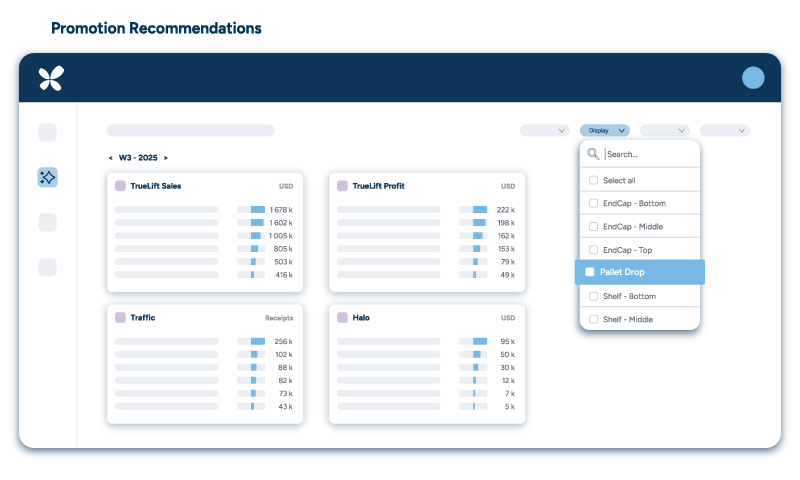
From here, I can select a product and go from an idea to a finished promotion with a few clicks.
I can do the same thing for multiple promotions simultaneously, using the system’s mass optimization to determine the discount depth of each item based on my goals. The accuracy is unbeatable, and the time savings enormous.
Learn more about the RELEX UI: How configurability delivers flexible, scalable planning
Q: So then, where do these plans go? How does the AI in the Promotions module impact other planning functions?
Jeff: Right. If your AI is creating these great data insights and promo plans, you need an easy way to share, update, and validate them with other teams. You don’t want to silo your AI.
This is where unified planning comes in.
With RELEX, you have a unified solution – a single platform where every team across planning functions uses a shared data pool and can communicate easily. When promo planners create a plan in the Promotions module, that plan is sent directly to the Forecasting & Replenishment (F&R) module, where the supply chain team can take a look and provide feedback.
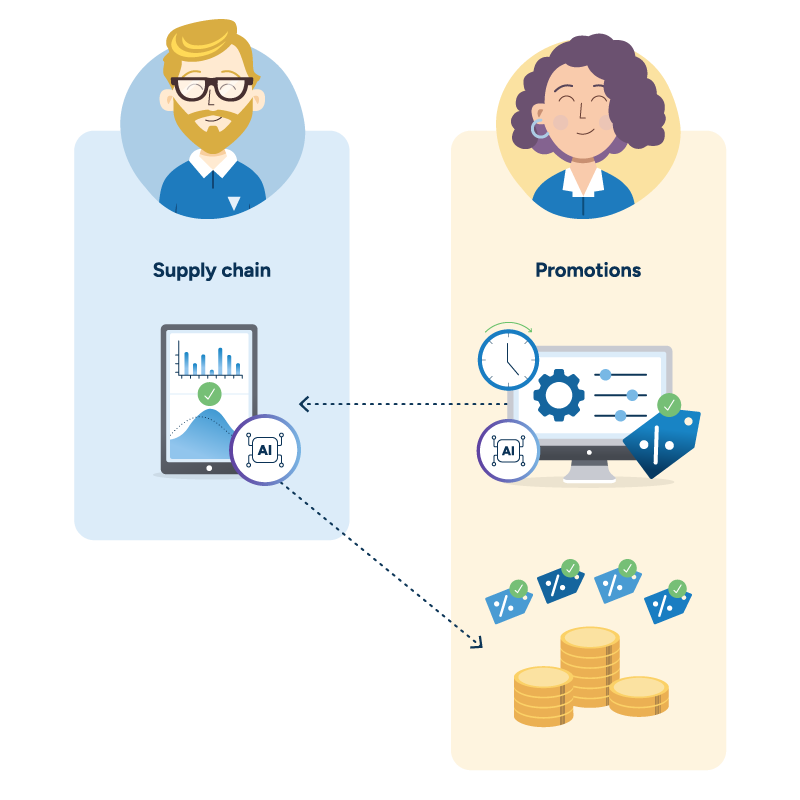
So, let’s say I want to run a promotion because it would drive significant profit. When I go to run it, I get alerts telling me there’s a projected stockout and an expected breach in capacity. The system pulls information from F&R and relays it to the promo planning interface. If I click Save, those same alerts go to the demand planners, and we can work together to find a solution that balances inventory limitations with profit opportunities.
A unified platform is also how you scale your AI. You’re unifying all these workflows, right? These teams communicate and make decisions based on the same data source. The AI in each of these different modules is constantly learning from and, in turn, enriching that data. Your outcomes are continuously improving, and your solution keeps adjusting to industry shifts, large and small.
Q: What are some of the broader impacts of this AI-driven unified planning on company strategy and objectives?
Jeff: It saves everyone from the dreaded ad planning meeting.
Listen. Ad planning meetings can be chaotic (sometimes contentious) gatherings because they involve so many stakeholders. You’ve got different category managers vying for endcaps. You’ve got supply chain planners arguing there isn’t enough inventory. Marketing is trying to prioritize vendor deals. Everybody has competing priorities and objectives. C-levels usually have to get involved because somebody has to have enough authority to make the final decision.
It’s an enormous resource spend.
Okay, so how does AI fix this? Once again, it comes down to data.
The data casts the deciding vote before the question even gets to the ad planning meeting. On the RELEX platform, AI helps determine optimal product placement based on forecasts and seasonality and enables store-specific promo decisions rather than blanket approaches.
The data casts the deciding vote before the question even gets to the ad planning meeting.
Since it’s a unified system, it’s already automatically checking for supply chain constraints, making it easier for teams to avoid working at cross purposes and run the best promotions possible. All of this is wrapped up with a neat little bow with automated reports that keep the various stakeholders informed.
With AI, retailers can generate data-driven promotions that target specific business objectives and deliver better results – with less time and effort. That’s the Holy Grail of promo planning.
Q: We’ve been slowly widening the scope of these benefits, so let’s take one more step back and talk about external partners. How does AI-driven promo planning affect vendor relationships?
Jeff: It will improve vendor negotiations because better negotiations rely on the same thing as unified planning – data.
RELEX AI gives you the data-driven negotiation points to get the maximum value out of promotions. That’s crucial for companies like grocery retailers who operate with razor-thin margins and rely heavily on vendor funding to boost profit.
Remember those vendor spreadsheets I mentioned? Planners can drop those spreadsheets into the RELEX solution, and our AI will assess them in seconds. Planners can accept the good promotions, reject the bad ones, and negotiate the middle-of-the-road options.
All of these decisions are backed up by data, which means planners can be very clear and very precise in their negotiations. Maybe a vendor is offering $0.10 per unit for a discount price of $0.89, but the planner can show the vendor why the retailer needs at least $0.13.
Let’s look at another example. Say my vendor requests a 10% promotion on an item, but the system is projecting negative profit.
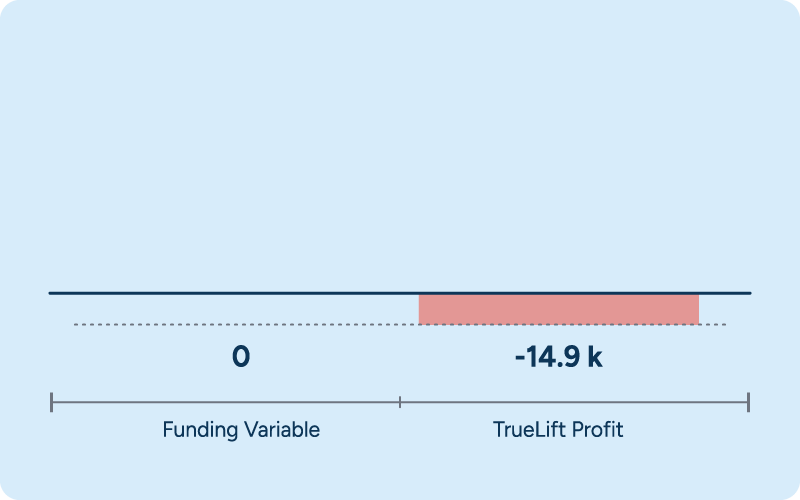
I go back to my vendor to work out a deal. With AI doing the heavy-duty calculations, I can test out a variable funding rule of, say, $1 per unit, and suddenly, we’re in the green.
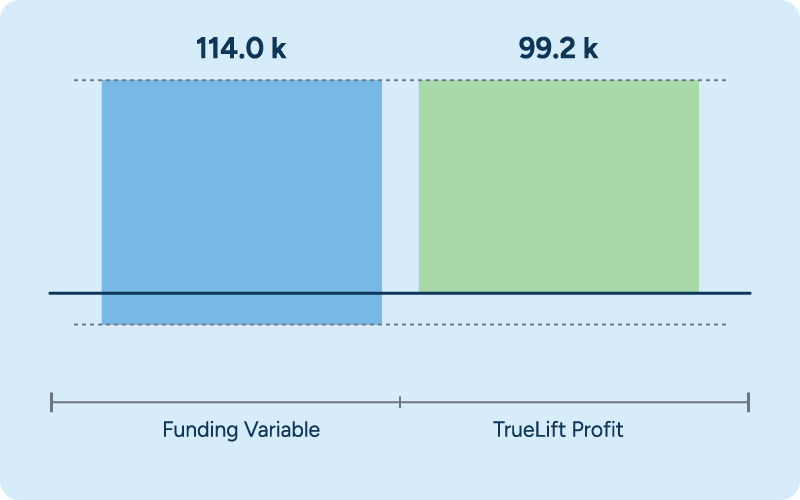
The vendor agrees to this price as long as I include them in the promotional email (which the system can also track). The system projects enough inventory to support demand, I confirm the expected uplift with the supply chain team, and the promotion is ready.
Most importantly, I am doing all this calculation, negotiation, and validation right now! I have the vendor on the Zoom call, sharing my screen and the associated results. Because the system performs rapid, in-depth analysis based on whatever parameters I choose, I can see immediately how each adjustment discussed during negotiations would affect expected uplift, profitability, inventory, and capacity.
The unified platform makes it easy for promo planners to reduce or eliminate the lag between negotiating their vendor agreement and confirming inventory availability.
Q: How could other verticals like CPG, manufacturing, and distribution benefit from using AI-driven promo planning?
Jeff: Good question. Let’s say you’re a CPG company. You’re in the vendor world.
What if you could use AI-driven promo planning for each retailer you supply? With this technology, you can provide extremely valuable insights such as: “Here’s how you can best use our funds. Here are the best items to promote and the best depth, given the data set you’ve given me.” You’d never use the word “attrition” again.
There are some major benefits here:
- Your retailer values your partnership for both the products and the insights you provide, elevating your standing as a vendor.
- You gain access to POS data to refine calculations, which means more efficient and profitable operations.
- If you charge for this service, you’ve just gained an extra revenue stream.
Q: We’ve covered a lot of ground here. Can you sum up the benefits for us? Why should companies across industries adopt AI-driven promo planning?
Jeff: There are four major benefits of implementing AI in promotions.
The first benefit is data-driven profitability. You’re not losing money on bad promotions. This is the sort of system that pays for itself – fast. We’ve had customers who earned $5-8 back on every dollar they spent in just the first year. That’s unprecedented ROI.
Second, you’re increasing your speed and accuracy exponentially. Using AI for promotions results in significant time savings. The system can analyze and present data quickly, easing the burden on promo planners and freeing them for more strategic tasks like managing vendor relationships. Fast analysis also improves your market presence and responsiveness. Customers know you’re dependable – you’ll have the products they want at good prices.
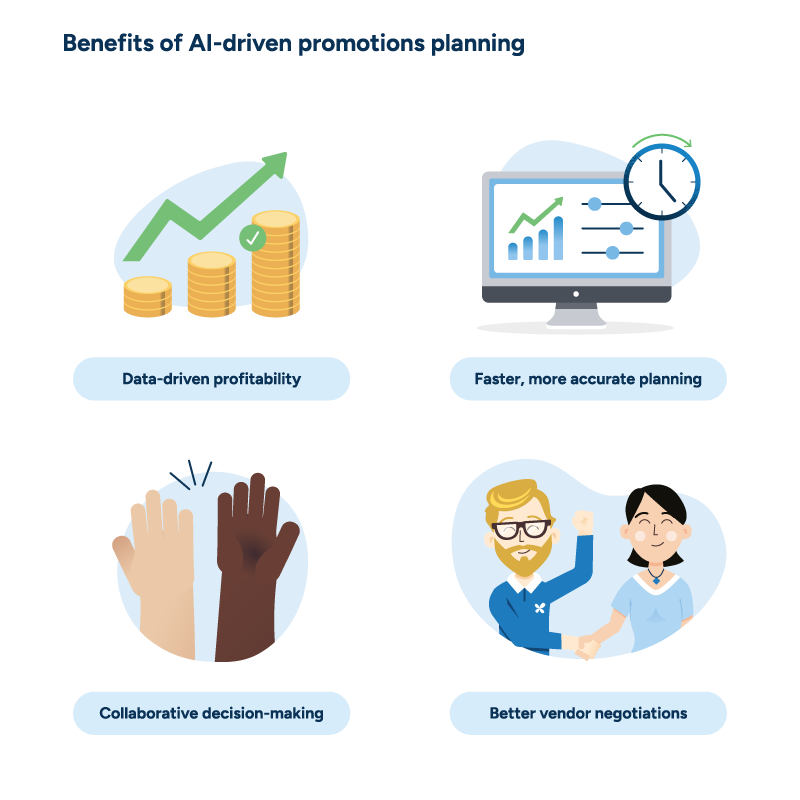
Third, you’re eliminating silos and cutting down on friction between teams for more collaborative planning. You can more easily balance every department’s planning limitations and objectives for smoother overall processes and better results.
Finally, your vendor negotiations are faster and more fruitful because both parties can understand viable options through clear, data-driven analytics.
If I sum it all up, the RELEX unified platform links decisions and shares data between every AI-driven planning function so retailers can ensure their promotions keep customers happy, traffic flowing, and profits high.

